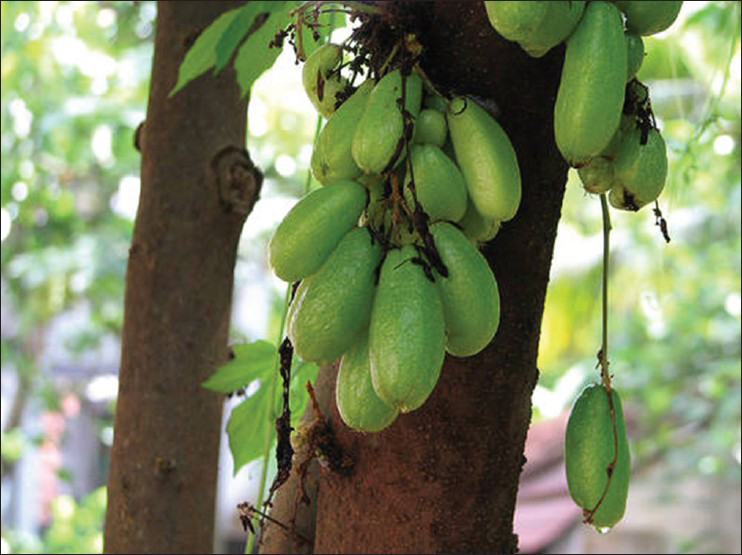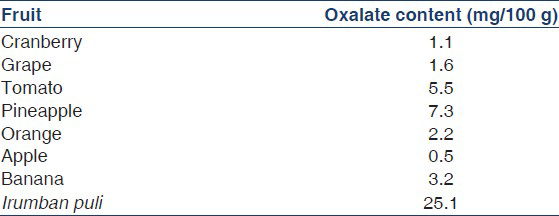Translate this page into:
Acute oxalate nephropathy due to ‘Averrhoa bilimbi’ fruit juice ingestion
This is an open-access article distributed under the terms of the Creative Commons Attribution-Noncommercial-Share Alike 3.0 Unported, which permits unrestricted use, distribution, and reproduction in any medium, provided the original work is properly cited.
This article was originally published by Medknow Publications & Media Pvt Ltd and was migrated to Scientific Scholar after the change of Publisher.
Abstract
Irumban puli (Averrhoa bilimbi) is commonly used as a traditional remedy in the state of Kerala. Freshly made concentrated juice has a very high oxalic acid content and consumption carries a high risk of developing acute renal failure (ARF) by deposition of calcium oxalate crystals in renal tubules. Acute oxalate nephropathy (AON) due to secondary oxalosis after consumption of Irumban puli juice is uncommon. AON due to A. bilimbi has not been reported before. We present a series of ten patients from five hospitals in the State of Kerala who developed ARF after intake of I. puli fruit juice. Seven patients needed hemodialysis whereas the other three improved with conservative management.
Keywords
Acute oxalate nephropathy
Averrhoa bilimbi
calcium oxalate
Irumban puli
Introduction
Acute oxalate nephropathy (AON) in cases of secondary oxalosis is the result of excessive oxalate accumulation because of increased ingestion, increased production, or decreased excretion of oxalate. The kidney is the primary organ for oxalate excretion and increased oxalate load may result in renal insufficiency.[12] Increased dietary intake of oxalate is fairly uncommon; however, there have been case reports in the literature describing excessive intake of star fruit (Averrhoa carambola) juice[34] and peanut intake[5] leading to oxalate nephropathy. Irumban puli (Averrhoa bilimbi) is a local fruit in South India which has high oxalic acid content. Excessive ingestion of fruit juice can lead to increased serum oxalate level which can cause deposition of calcium oxalate crystals in renal tubules and cause acute renal failure (ARF). We present a series of cases from five hospitals in the state of Kerala who developed ARF due to AON after consumption of I. puli juice.
Case Reports
Case 1
A 38-year-old man, who was working abroad and came to India on a vacation, underwent a health check up, which showed normal renal functions and hypercholesterolemia. He consumed a glass of I. puli fruit juice daily for 4 days for control of hypercholesterolemia. After 4 days, the patient developed abdominal discomfort, nausea, and loss of appetite. He presented to our center with the above-mentioned symptoms; he had normal urine output. On examination, the patient was conscious, oriented, blood pressure 150/90 mmHg; he had no edema, and his systems were normal. Investigations showed severe renal failure with serum creatinine of 6.4 mg/dl, with normal hemogram and liver function tests; urine analysis showed no albuminuria, and microscopy showed oxalate crystals. Ultrasonogram of abdomen was normal. The patient underwent two sessions of hemodialysis, following which a left percutaneous kidney biopsy was done. Kidney biopsy showed acute tubular necrosis with many polarizable fractured crystals in the tubular lumina (calcium oxalate crystals) [Figure 1a and b]. 24-h urinary oxalate was 60 mg/day. The oxalate content of the fruit was 25.1 mg per 100 g of the fruit, when analyzed in our lab by spectrophotometry method. He was on hemodialysis for 10 days. His renal functions improved to normal in 6 weeks (serum creatinine: 0.9 mg/dl).

- (a) Renal tubules showing features of acute tubular necrosis with fractured crystals in the lumen (LM: H and E, ×40), tubules with necrosis (bold arrow), intratubular fractured crystals (thin arrow); (b) Calcium oxalate crystals under polarized light (arrow); (c) Urine microscopy showing calcium oxalate crystals (envelope-shaped)
Case 2
A 57-year-old man, known to have type 2 diabetes mellitus (on diet control) and dyslipidemia (on statins) presented to us with a history of anorexia, nausea, and fatigue for 2 weeks after intake of I. puli fruit juice for 5 days; he was oliguric. He had a normal hemogram, with serum creatinine: 9.3 mg/dl, serum cholesterol: 180 mg/dl. Urine analysis showed 1+ Protein, and microscopic examination of the urine sample showed plenty of oxalate crystals. He was initiated on hemodialysis and subsequently underwent a left percutaneous kidney biopsy which showed acute tubular necrosis with intra tubular calcium oxalate crystals. He needed six sessions of hemodialysis. His renal functions became normal in about 5 weeks’ time.
Similar cases have been reported in other hospitals of Kerala. All the patients had history of consuming I. puli juice and developed renal failure. None of the patients had history of renal failure before consuming the fruit juice. The details of these ten patients are given in Table 1. All the patients were male, age ranging from 38 to 72 years. Six patients had pre-existing problems like diabetes mellitus or hypertension. Eight out of 10 patients had plenty of oxalate crystals in urine; all the patients had severe renal failure with serum creatinine ranging from 5.5 to 12.3 mg/dl. Seven patients required hemodialysis in view of severe renal failure; the remaining three patients were treated conservatively and renal functions returned to normal. Kidney biopsy was performed in seven patients. All the patients showed acute tubular necrosis with polarizable tubular crystals consistent with oxalate crystals [Figure 1]. The time taken for Serum creatinine to reach the normal level ranged from 2 to 6 weeks.

Discussion
ARF can occur as a result of acute oxalate nephropathy due to the deposition of calcium oxalate crystals within the renal tubules. Oxalate nephropathy can occur in both primary and secondary hyperoxaluria. Primary hyperoxaluria is a group of autosomal recessively inherited enzyme deficiencies that lead to the increased urinary excretion of oxalate. In Type 1 primary hyperoxaluria, there is a reduction of alanine glyoxylate aminotransferase activity in the liver, leading to an accumulation of oxalate.[1] Type 2 primary hyperoxaluria occurs due to a mutation of glyoxylate reductase/D-glycerate dehydrogenase, leading to the excretion of increased amounts of L-glyceric acid as well as oxalate.[2]
Secondary hyperoxaluria can occur due to increased dietary intake of oxalate, increased absorption of oxalate from the bowel (also known as enteric hyperoxaluria), and increased production of oxalate. Enteric hyperoxaluria results mainly from fat malabsorption, which leads to increased absorption of soluble oxalate from the colon. Calcium binds to the free fatty acids that cannot be absorbed. This reduces the normal calcium oxalate precipitation in the feces, thereby allowing the absorption of soluble oxalate from the gut. Enteric hyperoxaluria occurs in orlistat therapy,[67] Roux-en-Y gastric bypass surgery,[8] celiac disease, and Crohn's disease. Increased production of oxalate is mainly due to increased levels of oxalate precursors, more commonly glyoxylate, which is associated with ethylene glycol ingestion,[9] and less commonly ascorbic acid.[10]
A. bilimbi (commonly known as bilimbi, I. puli, Chemmeen Puli, bimbul) is a fruit-bearing tree of the genus Averrhoa, family Oxalidaceae. It is widely cultivated in the tropical countries. Bilimbi tree grows to a height of 5–10 metres.[11] The fruits are fairly cylindrical with five broad rounded longitudinal lobes, and are produced in clusters [Figure 2]. A. bilimbi fruits are very sour, and are used in the production of vinegar, wine, pickles, jams, and jellies and in the preparation of South Indian dishes.

-
Averrhoa bilimbi tree with fruits
A. bilimbi had been advocated for the treatment of hyperlipidemia, hypertension, and diabetes by different communities. In Indonesia, the fruit is used to treat hypertension and the decoction of the leaves is used for the management of diabetes.[12] In India, the leaves, flowers, and fruits have been used by some communities to treat hypercholesterolemia, hypertension, and diabetes. In rats, it has been shown that this fruit has a cholesterol-lowering effect.[13] The fruit is also used to treat tinea versicolor, beri-beri, cough, mumps, rheumatism, and scurvy. The high levels of oxalic acid found in bilimbi are probably responsible for its extremely low pH (0.9-1.5). The oxalate content of the fruit was found to be 25.1 mg/100 g of fruit when analyzed in our lab; this is very high compared to other fruits [Table 2].

Various renal and neurological side effects like muscle weakness, intractable hiccups, mental confusion, seizures after ingestion of star fruit (A. carambola) have been documented.[1415] A. bilimbi, which belongs to the same family, causing acute tubular necrosis due to high oxalate content has not been described before. Oxalic acid has a direct toxic effect on the renal tubules and interstitium, facilitates the development of oxalate crystals which are endocytosed by renal epithelial cells and promote a proliferative response. These crystals also stimulate specific genes in renal tubular cells, including the connective tissue growth factor gene leading to interstitial fibrosis.
All our patients had history of intake of I. puli juice. Eight patients had envelope-shaped calcium oxalate crystals in the urine. Seven patients who underwent kidney biopsy had intra tubular polarizable crystals of oxalate.
Conclusion
I. puli (A. bilimbi) is a traditional ingredient of various South Indian dishes, and is also used in various other South East Asian countries as a local remedy for various ailments like hypertension, diabetes, and dyslipidemia. When used in high concentrations, the fruit juice can lead to ARF due to acute tubular necrosis, owing to its high oxalate content, which results in intratubular oxalate crystal deposition. We conclude that it is not safe to consume high oxalate-containing fruits in large quantities.
Source of Support: Nil
Conflict of Interest: None declared.
References
- Oxalate synthesis, transport and the hyperoxaluric syndromes. J Urol. 1989;141:742-7.
- [Google Scholar]
- Long-term prognosis in primary hyperoxaluria type II (L-glyceric aciduria) Am J Kidney Dis. 1994;23:255-9.
- [Google Scholar]
- Acute oxalate nephropathy after ingestion of star fruit. Am J Kidney Dis. 2001;37:418-22.
- [Google Scholar]
- Acute deterioration of renal function induced by star fruit ingestion in a patient with chronic kidney disease. J Nephrol. 2006;19:682-6.
- [Google Scholar]
- Oxalate nephropathy with a granulomatous lesion due to excessive intake of peanuts. Clin Exp Nephrol. 2008;12:305-8.
- [Google Scholar]
- Acute oxalate nephropathy associated with orlistat, a gastrointestinal lipase inhibitor. Am J Kidney Dis. 2007;49:153-7.
- [Google Scholar]
- Enteric hyperoxaluria, nephrolithiasis, and oxalate nephropathy: Potentially serious and unappreciated complications of Roux-en-Y gastric bypass. Surg Obes Relat Dis. 2005;1:481-5.
- [Google Scholar]
- Acute oxalate nephropathy due to ethylene glycol ingestion. Kidney Int. 2006;69:203.
- [Google Scholar]
- Oxalate nephropathy with AIN due to vitamin C intake. Am J Kidney Dis. 2009;53:B58.
- [Google Scholar]
- The Encyclopedia of Fruit and Nuts. Ch.O, Wallingford: CABI Publishers; 2008. p. :575.
- [Google Scholar]
- Anti-diabetic activity of the semi-purified fractions of Averrhoa bilimbi in high fat diet fed-streptozotocin-induced diabetic rats. Life Sci. 2005;76:2827-39.
- [Google Scholar]
- Studies on the antihyperlipidemic properties of Averrhoa bilimbi fruit in rats. Planta Med. 2009;75:55-8.
- [Google Scholar]
- Intoxication by star fruit (Averrhoa carambola) in 32 uraemic patients: Treatment and outcome. Nephrol Dial Transplant. 2003;18:120-5.
- [Google Scholar]
- Intoxication by star fruit (Averrhoa carambola) in six dialysis patients? (Preliminary report) Nephrol Dial Transplant. 1998;13:570-2.
- [Google Scholar]







